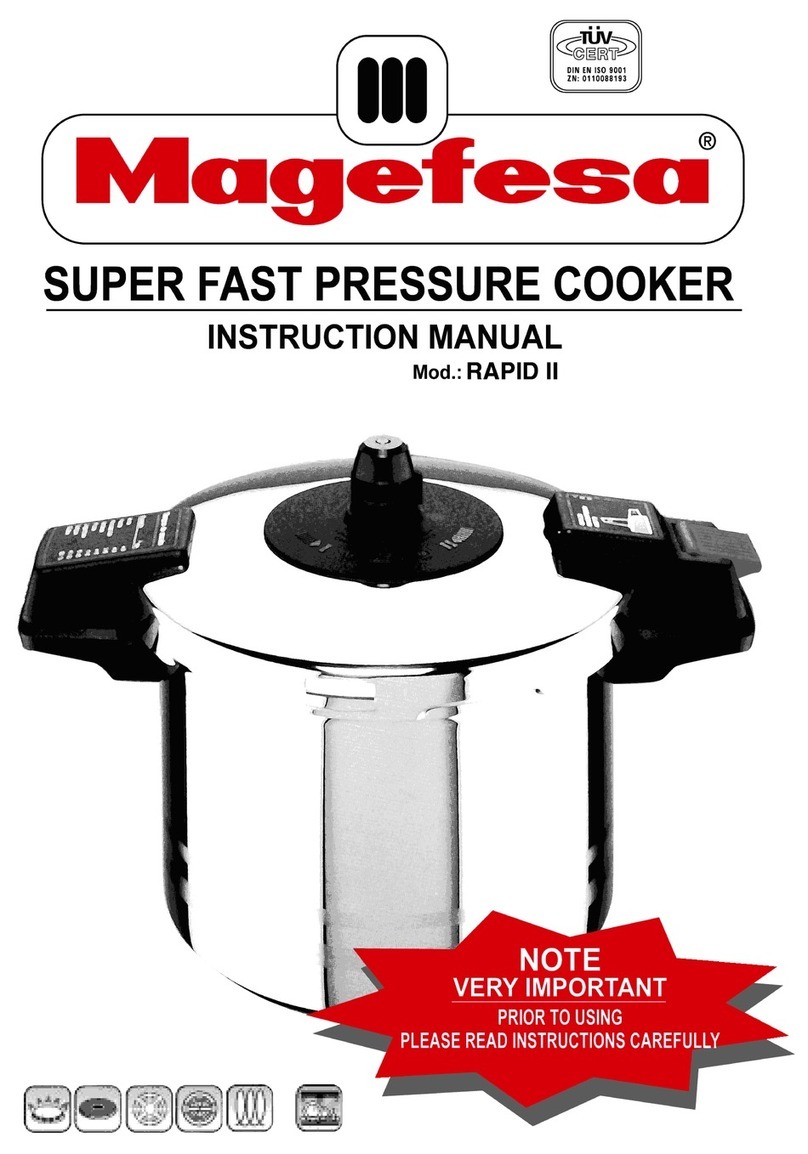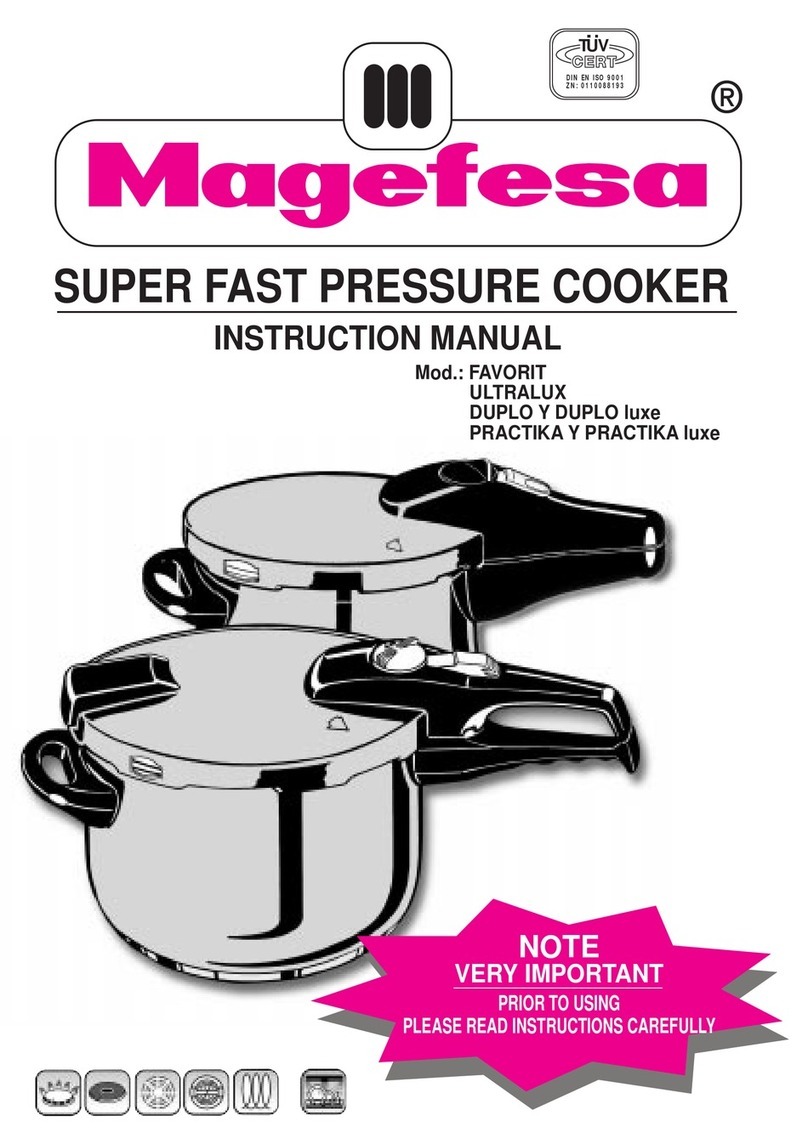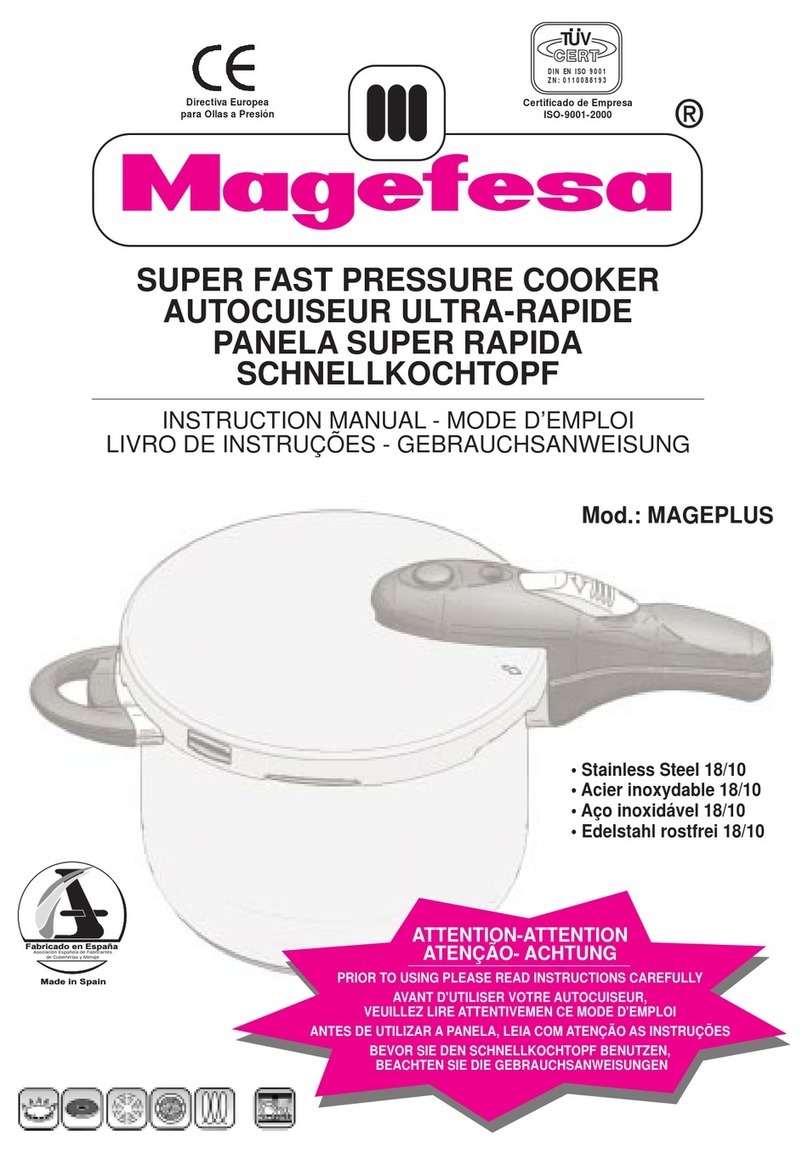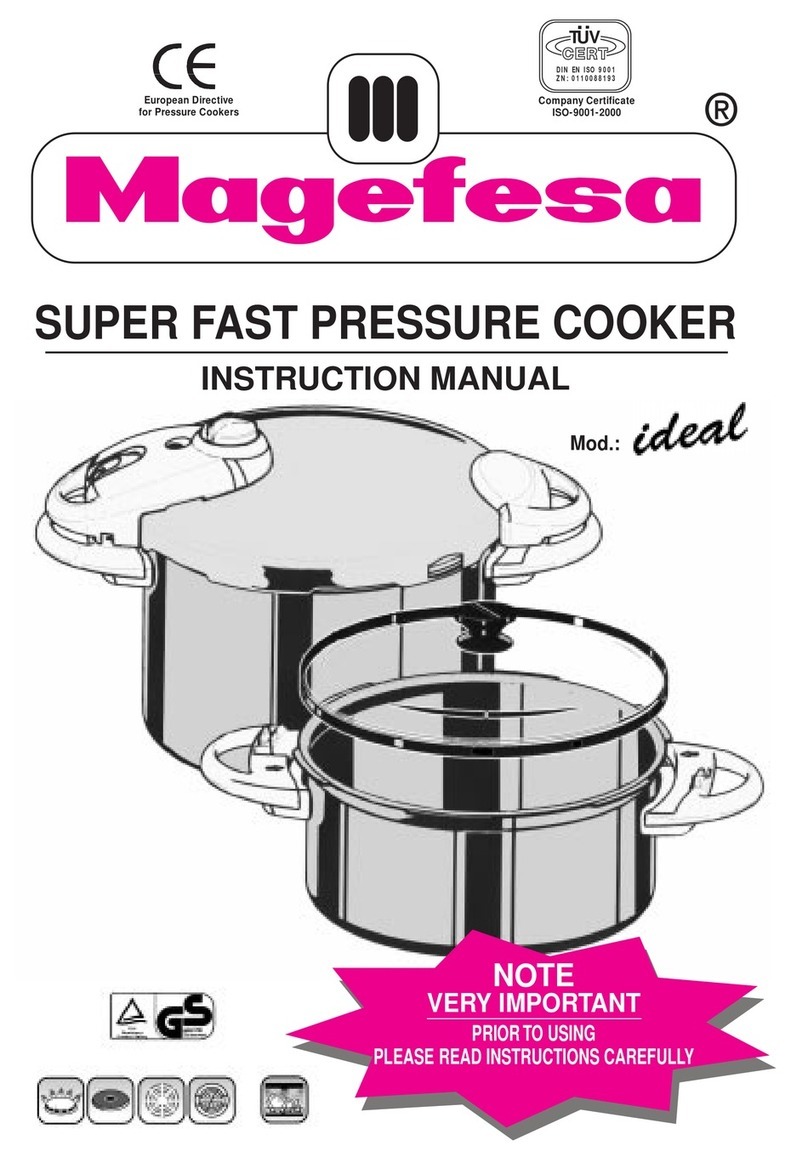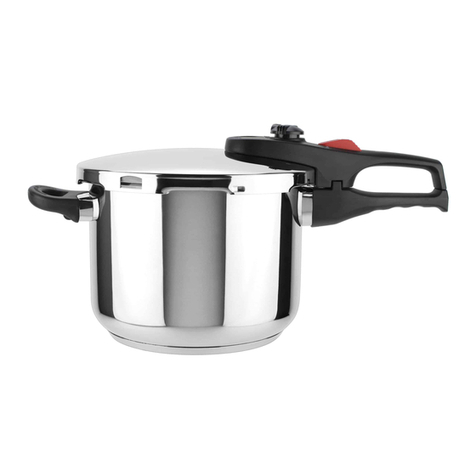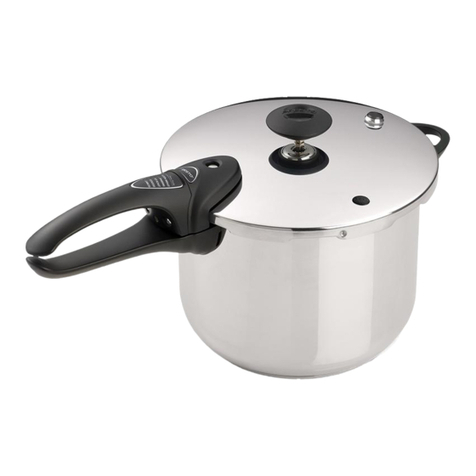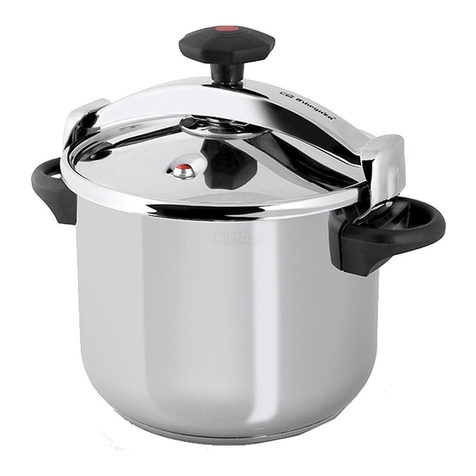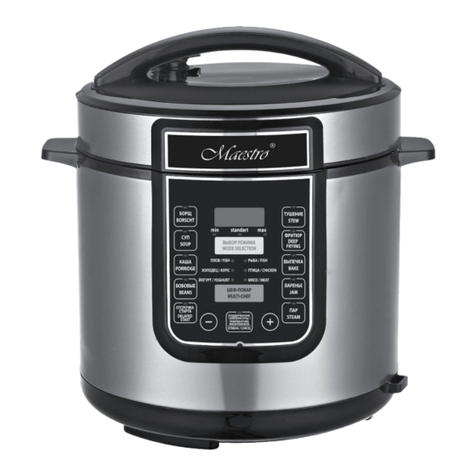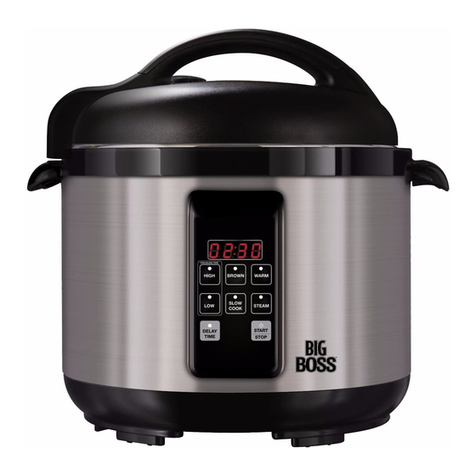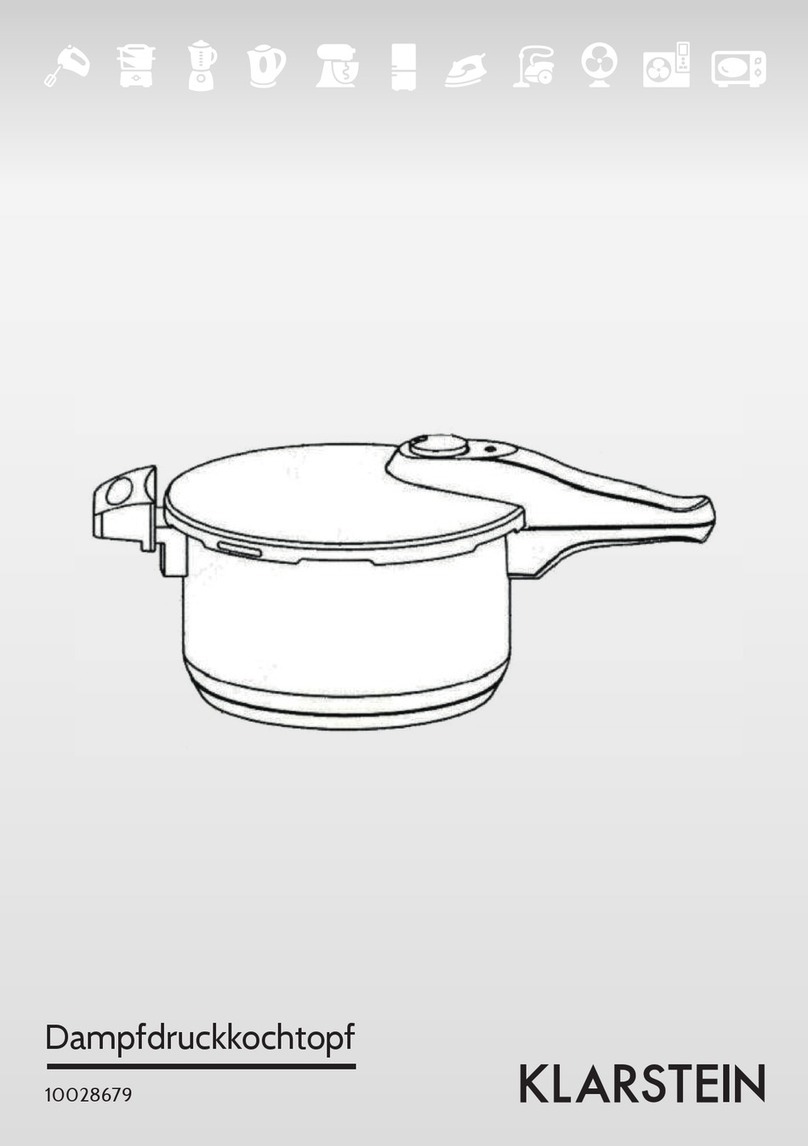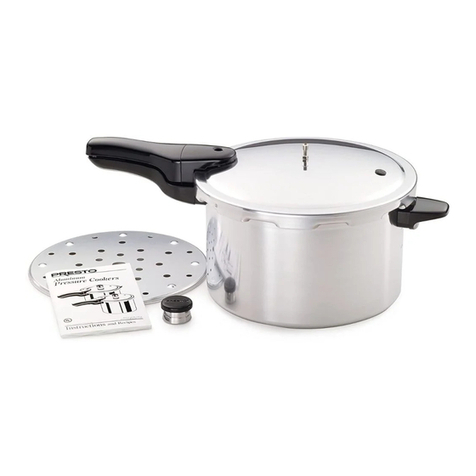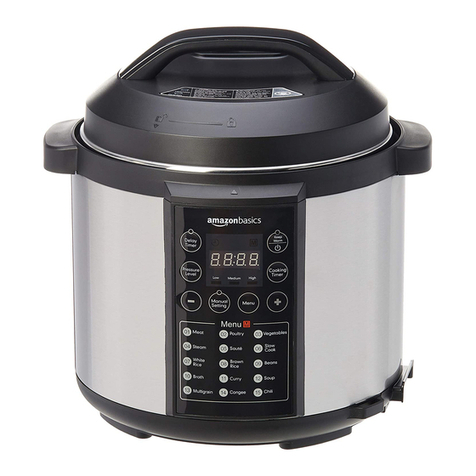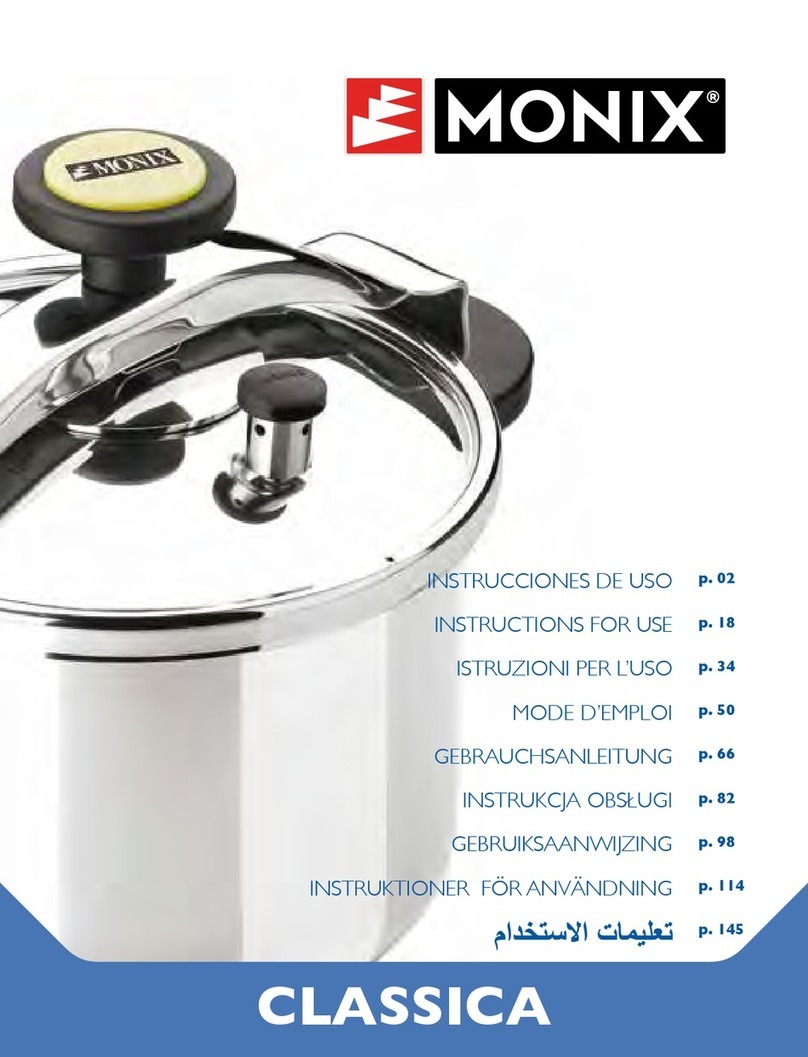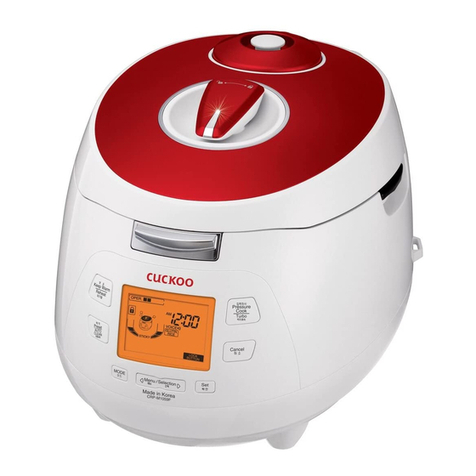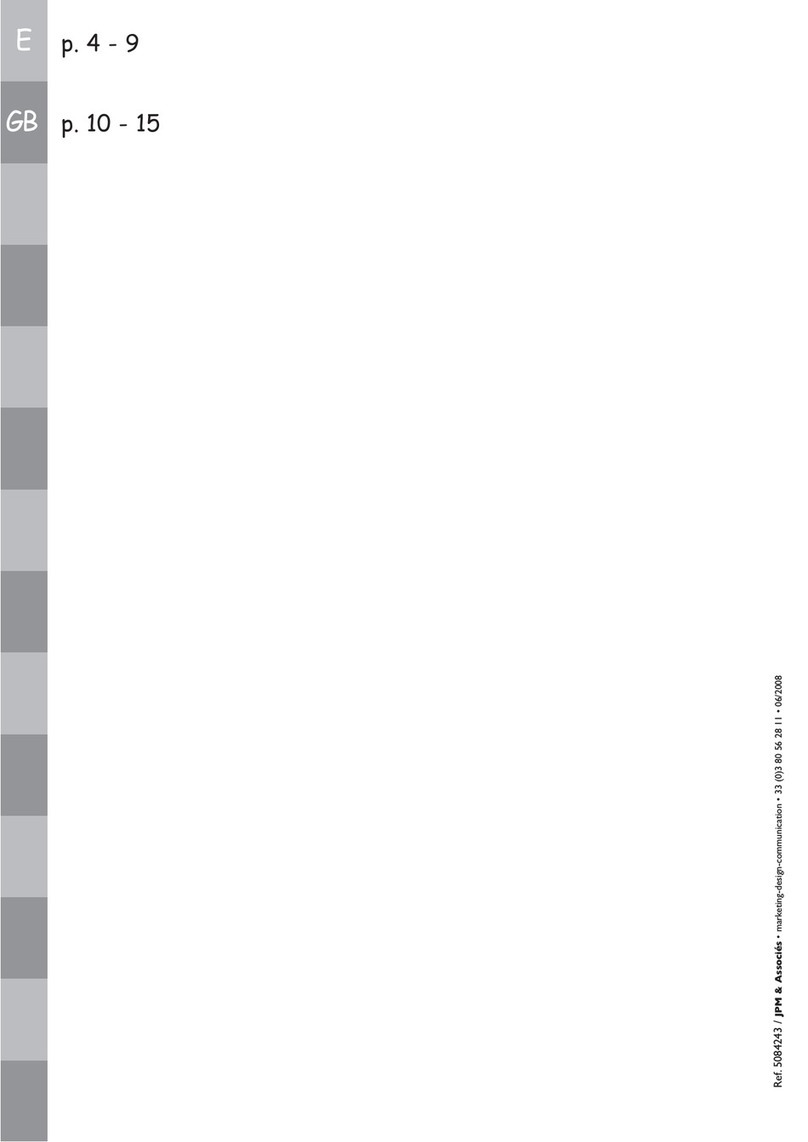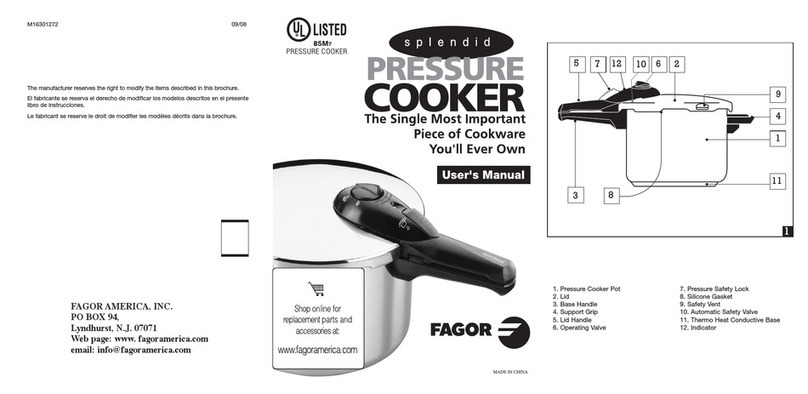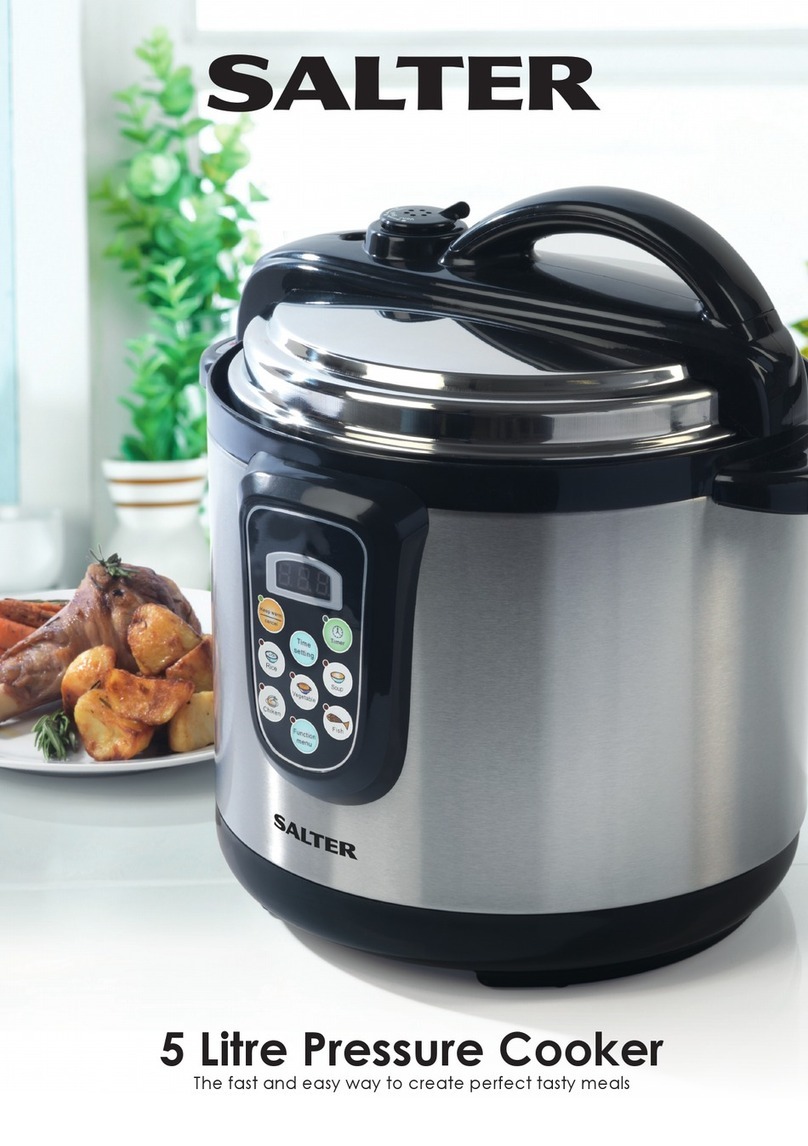Magefesa ARIAN User manual

SUPER FAST PRESSURE COOKER
INSTRUCTIONS MANUAL
TUV
DIN EN ISO 9001
ZN: 0110088193
Model: ARIAN
NOTE
VERY IMPORTANT
PRIOR TO USING
PLEASE READ INSTRUCTIONS CAREFULLY
Certificado de Empresa
ISO-9001-2000
Directiva Europea
para Ollas a Presión
Made in Spain
Fabricado en España
Asociación Española de Fabricantes
de Cuberterias y Menaje

10 - Lid
26-Sealing Gasket
35-Lid Handle
36-Body Handle
37-Pressure and Safety Detector Valve
38-Body
40-Body Side Handle
41 - Pressure Regulating Valve
51 - Basket Support (optional)
60-Steaming Basket (optional)
41 37
38
40
51
60
26
10 35
36
2
DESCRIPTION OF THE SUPER FAST PRESSURE COOKER
1
1
1
2
A
E
B
F
C
G
D
H
I
L
J K
M

3
Q - Keep these Instructions in a safe place.
IMPORTANT SAFEGUARDS
A - Read all the Instructions carefully.
B - Do not allow children near the area where
the Pressure Cooker is being used.
C - Do not place the Pressure Cooker in a hot
oven.
D - When the Pressure Cooker is pressurised it
should only be moved with maximum
precaution. Do not touch the hot surfaces.
Use the handles. If necessary use gloves.
E - Do not use the Pressure Cooker for any
other use than it’s intend purpose.
F - The Pressure Cooker cooks under pressure.
Injuries can be caused from scalding
through incorrect use. Make sure it is
correctly closed before placing it on the
heat.
G - Never open the Pressure Cooker using
force. Do not open the Pressure Cooker
until you are sure that the pressure inside
has been completely released.
H - Never use the Pressure Cooker without
water, as this would severely damage it.
I - Do not fill the Pressure Cooker to more
than 2/3 of its capacity. For foods that
swell during cooking, such as rice, dry
pulses or stewed fruit, only fill to half its
volume.
J - Use the heat sources in accordance with
their instructions for use.
K - After cooking meat with skin (i.e. tongue),
which has a risk of swelling due to high
temperature, do not pierce it whilst the
skin has a swollen appearance, as injuries
can be caused from scalding.
L - When cooking thick foods gently shake
the Pressure Cooker before opening the lid
to avoid splashing.
M- Always check that the valves are not
blocked before every use.
N - Never use the Pressure Cooker to fry foods
under pressure.
O - Only handle the safety systems to carry out
the necessary maintenance instructions
stipulated in the instructions for use.
P - Only use genuine parts in
accordance with the instructions that came
with your Pressure Cooker. It is important
that you only use genuine
the sealing gaskets appropiate for your
model of Pressure Cooker.
PRIOR TO EACH USE
Fig. 1 Fig. 2
Pay attention to the Pressure Cooker functioning
when used with children around.
CHIMNEY
Move the “Pressure Regulating Valve” to removal
position, pull upwards vertically, (Fig. A), and check
the chimney orifice inside the lid is completely clean.
If not, clean with a small rod (Fig. 1). To assemble,
reverse procedure: Placing “Pressure Regulating
Valve” in removal position push downards vertically
and turning clockwise.
DEPRESSURISING VALVE
Check it functions correctly by pressing the Pressure
detector with a rod through the inside part of the lid,
if it moves freely, the functioning is correct (Fig. 2).
FILLING THE PRESSURE
-For safety reasons the Pressure Cooker must not be
filled more than 2/3 of its capacity.
-Whencookingfoodwhichswellsorproducesfoam(such
as chickpeas, lentils, leeks, pasta, rice or vegetables)
fill only 1/2 of the Pressure Cooker capacity to prevent
obstruction of the valves mentioned above.
-Minimum amount of liquid in the Pressure Cooker
should be 1/4 litre.
ADVANTAGES OF THE SUPER RAPID
PRESSURE COOKER.
FASTER
Specially designed to cook as quickly as possible whilst
maintaining all the vitamins and flavours of the food.
MORE ECONOMIC
Since cooking is more rapid, you can economise on any
kind of energy used in the kitchen.
®
®

4
GREATER SAFETY
has made its Pressure Cooker the
safest on the market. Help us to maintain this position
by refusing any NON ORIGINAL spare part (particularly
"SEALING GASKET" which alter this safety).
5 SAFETY SYSTEMS
This Pressure Cooker has 5 safety systems:
1 and 2. - High security opening and closure device:
This mechanism located on the lid handle designed
to prevent the Pressure Cooker from being opened
when there is pressure inside, however small this
amount may be; in which case the "Pressure
Detector" will be in view and THE LID CANNOT BE
OPENED (Fig. L).
On the contrary when there is no pressure, it will be
hidden inside the hole on lid handle (Fig. M). In this
case it can be opened.
If the Pressure Cooker is not closed correctly, the
device will impede pressure from being generated.
Safety during functioning.
3-Pressure regulating valve.
Maintains the Pressure Cooker working pressure at
all times, allowing the excess steam out (Fig. B).
4-Depressurising valve.
Comes into action when there is an increase in
pressure (Fig. C). When this valve functions, it means
the chimney is obstructed. Remove the Pressure
Cooker from the heat and clean it (Fig, 1).
5-Lid window.
Should the two safety devices become obstructed
during functioning, the lid window allows the
"SEALING GASKET" to expand outwards thereby
expelling all the steam (Fig. D).
Should this occur, take it to a Technical Assistance
Service, as it is necessary to check the two systems
of “Safety during functioning” mentioned before.
The "SEALING GASKET" is made from special materials
enabling it to act as a safety system. Should you use
any other which is not an original, then you run the
risk of cancelling out this safety system.
OPERATING INSTRUCTIONS
-Never leave the Pressure Cooker unattended. Pay
attention to the steam emission through the
control valve.
-For the Pressure Cooker to come to pressure it
must always have water. It cannot be used with
oil only.
-Do not make any modifications to the safety
systems nor use fake sealing gaskets which are
not originals.
-If you are cooking pasty food, such as thick
soups, shake the Pressure Cooker slightly before
opening in order to avoid splashing.
TO OPEN THE PRESSURE COOKER
-Move the “Push Button” to the OPEN position (Fig.
E) and holding it down turn the lid towards the right
until it reaches the limit (Fig. F).
TO CLOSE THE PRESSURE COOKER
-Place the lid over the body so the arrow marked on
the lid coincides with that of the body handle (Fig.
G), thereby fitting the lid onto the body.
- Turn the lid in a clockwise direction until it reaches
the limit (Fig. H) with the push button in OPEN
position. The push button will automatically move
all the way back (Fig. I), if not do it manually.
The "High security device" prevents the Pressure
Cooker from getting pressure if the lid has not
been correctly closed.
COOKING WITH PRESSURE
COOKER. OPERATING PRESSURE
-Place the Pressure Cooker on the hotplate with the
heat source regulated to maximum.
Now two methods can be used:
1. If you wish to use low pressure move the “Pressure
Regulating Valve” to position 1 This will enable you to
soften food, finish a meat stew, etc.
2. If you wish to use high pressure, and therefore high
temperatures and a shorter cooking time (super-
rapid cooking) move the “Pressure Regulating
Valve” to position 2. (Fig. I)
In both cases, after a certain time you will notice
small amounts of necessary steam coming out
through the “Pressure Detector” to expel the air
from inside the Pressure Cooker. This will shortly
disappear, once the aforementioned device comes
up and closes off the steam outlet. This is when the
Pressure Cooker begins to have pressure.
The cooking times are calculated from the
moment steam starts to come out of the
"Pressure Regulating Valve" orifice, when this is
in position 2.
At this time heat intensity should be reduced
sufficiently to allow a small outlet of steam through
the "Pressure Regulating Valve".
During cooking it is NORMAL to notice small steam
losses through the safety valves.
If using gas for cooking, the flame must be controlled
right from the start, preventing it from coming out
round the bottom. The Pressure Cooker must be
centred over the heat source. This way energy will
be saved and the "Handles" and "SEALING GASKET"
will be protected against deterioration.
END OF COOKING TIME.
OPENING THE PRESSURE COOKER
-Once the cooking has finished remove the Pressure
Cooker from heat source even if this is switched off.
-Allow pressure to be dropped completely and naturally.
®
®

Model Type Position Operating Pressure
0,00 kgs / cms2
ARIAN
B.I.L.R.I.S. 220 Capacity 2,7-3-4-6-8 litres
1 0,55 kgs / cms2
2 0,80 kgs / cms2
5
- Turnthe"PressureRegulatingValve"todecompression
postion (Fig. J) until all the steam has come out from
inside.
-Check the "Pressure Detector" is hidden inside the
"Lid handle" (Fig. M), only then can the Pressure
Cooker be opened.
-Should this not be possible put the Pressure Cooker in
the sink and allow a small stream of cold water to,
pour over the lid until the "Pressure Detector" becomes
hidden.
NEVER SUBMERGE THE PRESSURE COOKER IN
WATER.
-Move the "Push Button" to the OPEN position (Fig. E)
and holding it down move the lid towards the right
until it reaches the limit (Fig. F).
Never force the lid to open it.
PRACTICAL ADVICE
You will save energy, if after turning off the heat source;
the Pressure Cooker is left on the hotplate taking
advantage of the residual heat until the pressure drops.
Should a lot of steam come out through the lid or the
"Valve", this means the Pressure Cooker has not been
closed correctly.
The causes could be several:
a)The lid did not reach the limit on closure.
b)The "Pressure Regulating Valve" is in decompression
position move it to position 2.
c) Although the Pressure Cooker has been closed
correctly, it has reached operational pressure.
d)The"SEALING GASKET" is not fitted properlyinthelid.
e) The "SEALING GASKET" is worn out, in which case it
must be replaced by a original.
MAINTENANCE AND CLEANING
To keep your Pressure Cooker like
the first day, we recommend washing it in warm
water after use following the instructions below.
A) LID
-Never put it in the dishwasher.
-Clean the chimney orifice with a fine rod (Fig. 1) and
the "Pressure Safety and Detector Valve" pushing the
rivet with a rod (Fig. 2). Both these actions being
complemented with a small stream of water. Do not
dismantle the valve.
B) BODY
- Wash as normal or in the dishwasher.
-From time to time depending on the food and
additives used for cooking, as well as the lime
content of the water used, small bluish or white
stains might appear on the bottom, which are
deposits on the steel; however these do not affect
the properties.
All these stains will disappear on rubbing with
vinegar.
Never leave bleach inside (not even diluted with
water) nor tomato sauce nor salty water for
long periods of time to prevent corrosions.
C) CLOSURE SEAL
-Itisspeciallymadefromlonglastingmaterialwashitafter
eachuse,removingitfromits housing. Onceitisdry putit
back in place. (Fig. K).
-After a long period of use it must be replaced
with a new original to prevent any
possible steam leak from the Pressure Cooker and to
guarantee its correct functioning.
The sealing gasket seal is considered worn out
from use when it starts to lose steam from here
and insufficient pressure is reached.
WARNINGS
Once you have cleaned your Pressure Cooker, store it with
thelidupside downontop of thepanso that thepartsare
aired.
If you note anything unusual in the operation of your
Pressure Cooker, take it to the nearest Approved Service
Centre for it to be checked. It is, anyway, advisable to
take it to one of these Service Centres after prolonged
use (approximately every 2 years) to check that it is
working correctly.
PLEASE NOTE
The gasket is considered worn out when, due to use,
the Pressure Cooker starts to lose steam through it
and does not reach the required pressure.
CMD-S.L. is only responsible for correct operation of all its
manufactured goods when they are fitted with:
ALWAYS AND EXCLUSIVELY USE
ORIGINAL REGISTERED
TRADEMARK SPARE PARTS
FOR YOUR OWN SAFETY!
®
OPERATING PRESSURES
®
®
®
Table of contents
Languages:
Other Magefesa Electric Pressure Cooker manuals
